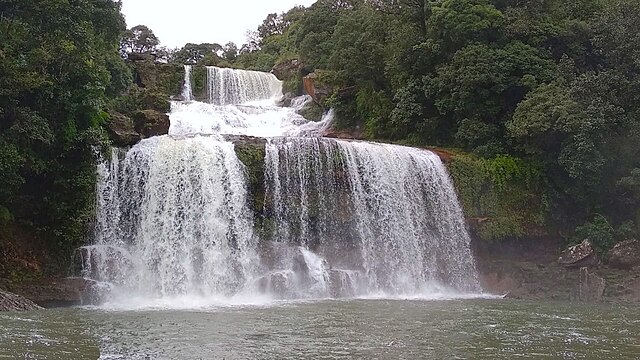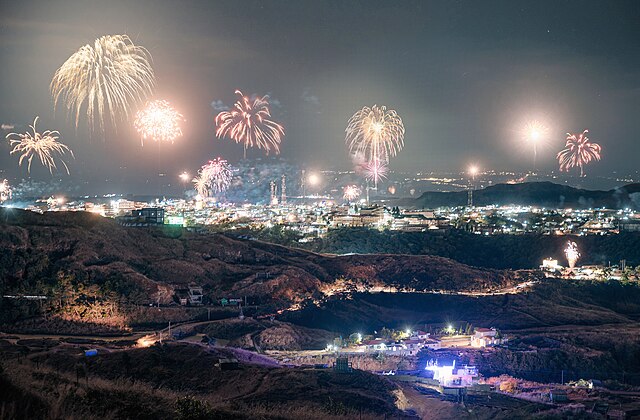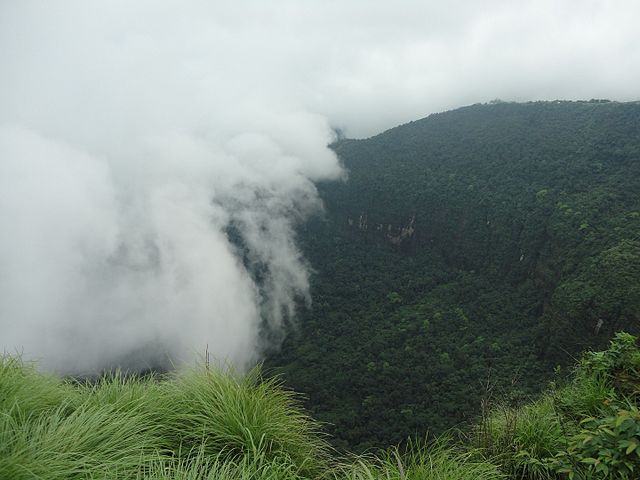Have you ever wondered what it’s like to live in a place where rain isn’t just a weather event—it’s a way of life? Welcome to Cherrapunji, a small town in Meghalaya, India, that holds the extraordinary distinction of being one of the wettest places on our planet. If you’re curious about Cherrapunji weather, you’re in for quite a journey through monsoons, mists, and meteorological marvels that will leave you both amazed and perhaps a little soggy just thinking about it.
What Makes Cherrapunji Special?
Location and Geography
Nestled in the East Khasi Hills of Meghalaya, Cherrapunji (also known as Sohra) sits at an elevation of about 4,823 feet above sea level. This isn’t just any hill station—it’s positioned like nature’s own rain-catching amphitheater. The town overlooks the plains of Bangladesh, creating a perfect storm (quite literally) for extraordinary weather patterns.
Think of Cherrapunji as sitting on the edge of a giant natural funnel. The Bay of Bengal sends moisture-laden winds northward, and when these winds hit the Khasi Hills, they’re forced upward, cool down, and release their watery cargo. It’s like nature’s own irrigation system gone absolutely wild.
The Rain Capital of the World
When we talk about Cherrapunji weather, we’re essentially talking about rain in its most dramatic form. This place doesn’t just get wet—it gets biblical-flood-level wet. While other places around the world might boast about their rainy seasons, Cherrapunji has turned receiving rainfall into an art form.
The town has held various world records for rainfall, and even today, it remains one of the top contenders for the wettest place on Earth. But here’s what’s fascinating: despite all this rain, Cherrapunji faces water shortages during the dry months. It’s like having a feast and a famine in the same year, every year.
Understanding Cherrapunji’s Climate Patterns
Monsoon Season Dominance
The secret behind Cherrapunji’s incredible weather lies in its relationship with the monsoons. The southwest monsoon winds, loaded with moisture from the Bay of Bengal, arrive here like clockwork. But unlike other places where monsoons bring steady, predictable rain, Cherrapunji experiences what meteorologists call “orographic precipitation.”
Simply put, when those moisture-heavy winds hit the steep hills around Cherrapunji, they’re forced to climb rapidly. As they rise, they cool down dramatically, and all that water vapor condenses into rainfall. It’s like wringing out a giant sponge in the sky, day after day, for months on end.
The Role of Topography
Geography isn’t just about maps and locations—in Cherrapunji, it’s about survival. The unique topography creates a microclimate that’s unlike anywhere else on Earth. The steep southern face of the Khasi Hills acts like a barrier, trapping clouds and forcing them to dump their contents before moving on.
This geographical setup is so effective that you can literally drive a few kilometers away from Cherrapunji and find yourself in a completely different climate zone. It’s like nature drew invisible boundaries where the rain stops and starts.
Seasonal Weather Breakdown

Summer Weather (March to May)
Before the monsoon fury begins, Cherrapunji experiences what locals call the “calm before the storm.” Summer months are relatively pleasant, with temperatures ranging from 20°C to 25°C (68°F to 77°F). The weather is mild, humidity levels are manageable, and you might actually see the sun on most days.
Temperature and Humidity Levels
During summer, humidity levels hover around 70-80%, which is comfortable compared to the monsoon months. The cool elevation keeps temperatures from soaring, making this the most pleasant time weather-wise. You’ll experience cool mornings, warm afternoons, and pleasant evenings—basically, what most people would consider perfect weather.
Monsoon Season (June to September)
Now, this is where Cherrapunji weather gets serious. The monsoon season isn’t just rain—it’s a complete transformation of the environment. Imagine turning on a tap and forgetting to turn it off for four months straight. That’s monsoon season in Cherrapunji.
Peak Rainfall Months
July and August are the champions of wetness. During these months, Cherrapunji can receive over 2,500mm of rainfall—that’s more than what many countries get in an entire year, happening in just 30 days. The rain doesn’t come in gentle showers; it arrives in torrential downpours that can make you question the very concept of “weather.”
Daily Weather Patterns
A typical monsoon day in Cherrapunji starts with overcast skies and high humidity. By mid-morning, the first drops begin, often starting as a light drizzle that gradually builds into steady rainfall. Afternoons bring the heaviest downpours, with rain so intense that visibility drops to just a few meters.
The interesting thing about Cherrapunji’s daily weather pattern is its consistency. Unlike places where rain comes and goes unpredictably, here you can almost set your watch by the rainfall. It’s nature’s own schedule, and it rarely deviates.
Post-Monsoon Period (October to November)
As the monsoons retreat, Cherrapunji enters a transitional phase. The rain doesn’t stop abruptly—instead, it gradually decreases, like someone slowly turning down the volume on nature’s soundtrack. October still sees significant rainfall, but November marks the beginning of the dry season.
This period offers some of the best views in Cherrapunji. The air is crystal clear after months of rain-washing, and you can see for miles across the plains of Bangladesh. It’s like nature’s own spring cleaning has just finished.
Winter Weather (December to February)
Winter in Cherrapunji is delightfully mild, with temperatures ranging from 11°C to 24°C (52°F to 75°F). This is when the town experiences its “dry” season—though “dry” is relative when you’re talking about one of the wettest places on Earth. You might still get occasional light showers, but nothing compared to the monsoon deluge.
The weather during winter is what most tourists dream of—clear skies, comfortable temperatures, and low humidity. It’s the complete opposite of the monsoon season, making you wonder if you’re in the same place.
Record-Breaking Rainfall Statistics
Annual Precipitation Records
Cherrapunji holds some mind-boggling rainfall records that sound almost fictional. The town receives an average of 11,777mm (463.7 inches) of rainfall annually. To put that in perspective, London gets about 690mm per year, and even Seattle, famous for its rain, only gets around 950mm annually.
The record-breaking year was 1861, when Cherrapunji received an astronomical 26,461mm (1,042 inches) of rainfall. That’s over 87 feet of rain in a single year! It’s like having a small building’s worth of water fall from the sky.
Single-Day Rainfall Records
The single-day rainfall record is equally impressive. On June 16, 1995, Cherrapunji recorded 1,563mm (61.5 inches) of rain in just 24 hours. Imagine trying to measure that with a regular rain gauge—you’d need something the size of a small swimming pool.
These aren’t just numbers; they represent a weather phenomenon so extreme that it challenges our understanding of what’s possible in terms of precipitation.
Best Time to Visit Cherrapunji
Weather Considerations for Tourists
Planning a trip to Cherrapunji requires serious weather strategy. If you want to experience the full fury of nature’s water show, visit during the monsoon months (June to September). But be prepared for limited visibility, challenging travel conditions, and the possibility of being stuck indoors for days.
For a more comfortable experience, October to May offers the best weather conditions. You’ll still get to see the lush green landscapes created by all that monsoon rain, but without the extreme weather conditions.
What to Pack for Each Season
Packing for Cherrapunji is like preparing for multiple climates in one trip. During monsoon season, waterproof everything is essential—clothing, bags, electronics covers, and sturdy waterproof footwear. Don’t bother with umbrellas; they’re useless against Cherrapunji’s horizontal rain.
For the dry season, pack layers. Mornings and evenings can be quite cool, while afternoons are pleasantly warm. A light rain jacket is still advisable because weather in Cherrapunji can change quickly.
How Cherrapunji Weather Affects Daily Life

Local Adaptations
Living in Cherrapunji means adapting to extreme weather as a normal part of life. Houses are built on stilts to handle flooding, and most homes have elaborate drainage systems. The famous living root bridges of the region aren’t just tourist attractions—they’re practical solutions to crossing streams that become raging torrents during monsoon season.
Local residents have developed a rhythm that follows the weather patterns. During heavy rainfall periods, indoor activities dominate daily life. Markets, schools, and businesses operate around weather forecasts in ways that most of us can’t imagine.
Agriculture and Weather
The extreme rainfall creates unique agricultural opportunities and challenges. While the abundant water supports lush vegetation and unique crops, the intense monsoons can also destroy crops and make farming incredibly challenging.
Local farmers have developed techniques passed down through generations to work with, rather than against, the extreme weather. Traditional farming methods here are essentially lessons in weather adaptation.
Climate Change Impact on Cherrapunji
Changing Rainfall Patterns
Recent decades have shown some concerning changes in Cherrapunji’s weather patterns. While the town still receives enormous amounts of rainfall, the distribution has become more erratic. Some years see less rain than historical averages, while others break new records.
Climate scientists are studying these changes to understand how global climate change might be affecting even the world’s wettest places. The implications extend beyond Cherrapunji, offering insights into how extreme weather patterns might evolve globally.
Weather Forecast and Monitoring
Modern Weather Prediction
Today’s weather forecasting technology has made living with Cherrapunji’s extreme weather somewhat more manageable. Satellite imagery, advanced radar systems, and computer modeling help predict the intensity and timing of rainfall with increasing accuracy.
The Indian Meteorological Department maintains specialized monitoring equipment in the region, contributing valuable data to global weather research. This information helps not just local residents but also scientists worldwide studying extreme weather phenomena.
Conclusion
Cherrapunji weather represents one of nature’s most spectacular displays of atmospheric power. From record-breaking rainfall that defies imagination to the unique adaptations of people living in harmony with extreme weather, this small town in Meghalaya offers lessons about resilience, adaptation, and the incredible diversity of our planet’s climate systems.
Whether you’re planning a visit, studying meteorology, or simply curious about extreme weather, Cherrapunji stands as a reminder of nature’s awesome power and the remarkable ways humans adapt to even the most challenging environments. The next time you complain about a rainy day, remember Cherrapunji—where rain isn’t just weather, it’s a way of life that has shaped everything from architecture to agriculture, from daily routines to generational wisdom.
Understanding Cherrapunji weather gives us insights not just into this unique location, but into the broader patterns of our changing climate and the resilience of communities who have learned to thrive in Earth’s most extreme conditions.
Frequently Asked Questions
1. How much rain does Cherrapunji actually get compared to other places? Cherrapunji receives an average of 11,777mm of rainfall annually, which is about 17 times more than London (690mm) and 12 times more than Seattle (950mm). During peak monsoon months, it can receive more rain in a single month than most cities get in an entire year.
2. Is it possible to visit Cherrapunji during monsoon season? Yes, but it requires careful planning and realistic expectations. Roads can become impassable, visibility is extremely limited, and outdoor activities are nearly impossible. However, witnessing the monsoon fury firsthand is a unique experience for weather enthusiasts willing to deal with the challenges.
3. Why does Cherrapunji face water shortages despite receiving so much rain? The extreme rainfall occurs only during monsoon months (June-September), while the rest of the year is relatively dry. The rocky terrain and steep slopes mean most rainwater runs off quickly rather than being retained in groundwater or reservoirs, leading to shortages during dry months.
4. How do people in Cherrapunji cope with such extreme weather conditions? Local residents have developed numerous adaptations over generations, including houses built on stilts, sophisticated drainage systems, waterproof storage methods, and seasonal lifestyle adjustments. Traditional architecture and the famous living root bridges are examples of working with, rather than against, the extreme weather.
5. Has climate change affected Cherrapunji’s rainfall patterns? Recent studies suggest that while Cherrapunji still receives enormous amounts of rainfall, the patterns have become more erratic. Some years see below-average rainfall while others break new records, indicating that even the world’s wettest places are experiencing climate variability related to global climate change.

